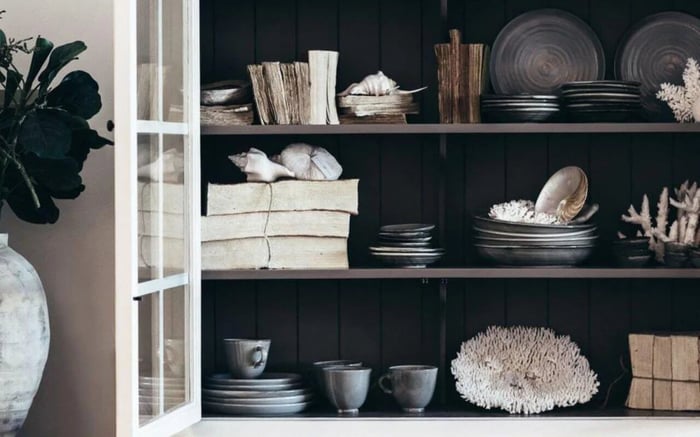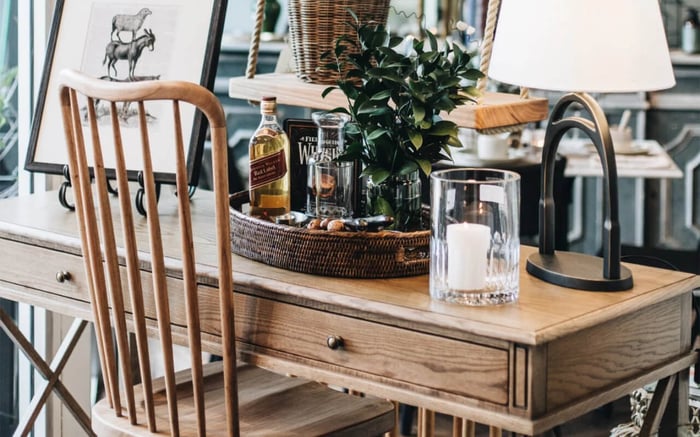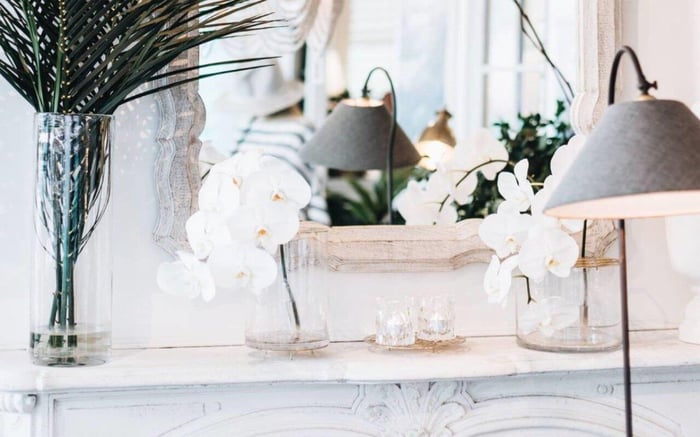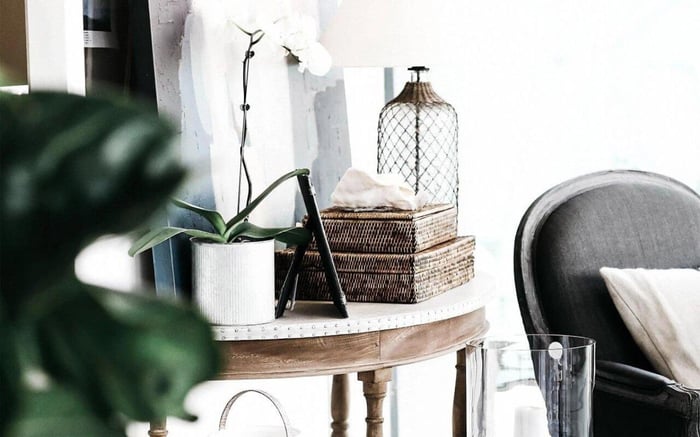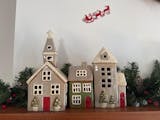Today we are sharing 5 insider bookshelf styling tips that you can try in your own home. Bookshelves are a versatile design feature that's function spans beyond simply storing your favourite books.
Bookshelves provide the opportunity to showcase the inner workings of your personality, interests, decor style, and seasonal accents and, most importantly, reflect what you value most.
While there is no 'one way' to decorate a beautiful, curated bookshelf, there are some key styling guidelines we love to follow to ensure that you create a visually balanced and cohesive look.
BOOKSHELF STYLING TIPS: CHOOSE A COLOUR PALETTE
Decor Style & Colour Palette
We recommend exploring our Style Library for step-by-step styling tips for a range of decor styles or take our Interior Style Personality Quiz if you are still discovering your unique style.
BOOKSHELF STYLING TIPS: LIGHTING
- Mood Lighting: Salt lamps, flameless candles, lanterns, fairy lights, tea lights, and taper candles.
- Task Lighting: Cordless/battery-operated table lamps can be styled to create clusters of illumination and draw the eye in.
- Accent lighting: Wall sconces and LED picture lights can be placed above your built-in or free-standing bookshelf. Under-cabinet lighting and LED strips will create a warm, soft glow that will light up every shelf on your bookcase.
BOOKSHELF STYLING TIPS: ACCESSORISE: LIVING, LUSTRE, LOVED.We always accessorise with something loved, something living, and something with lustre, balancing old and new items to achieve a look that is visually considered.
If your existing bookshelf decor is no longer exciting you, we suggest 'shopping your home,' as you will be surprised how many items can be repurposed in new and creative ways!
This encourages you to think beyond the pure function of the decor, as you can start to consider the shape, texture, and colour of your items.
Something Living:
Fresh cut greenery, faux plants, and flowers, branches, pinecones, coral, shells, or driftwood.
Something Loved:
Large ceramic or glass vessels and vases, leaning framed or propped artwork, picture frames, vertical and horizontally stacked books, decorative bookends, woven baskets, family or travel heirlooms, sculptural pieces, coral, boxes, and seasonal accents.
Something with Lustre:
Incorporate natural glass crystal, obelisks, candleholders, clocks, reflective surfaces, and muted brass, gold, pewter, and bronze elements.
BOOKSHELF STYLING TIPS: Layering
- Contrasting Heights, Shapes & Scale: Add larger, vertical layers (at least one on each shelf) to prevent the design from looking cluttered. Soften up harder lines from sculptural art/boxes/books/art with organic, round shapes through vases, jars and bowls.
- Balancing Colours: If you opt for a bolder base colour such as black or charcoal in the middle of the shelf, balance it out with a black item on the top and lower shelving as well. Consider an additional accent colour or metallic detail to be woven throughout the composition.
- Layering Textures & Materials: Incorporate a variety of materials and surfaces for visual richness. Combinations include wood + horn, natural rattan & glossy marble, chalky ceramics & crystal glass or metallic accents.
- Different Planes: Positioning taller and larger items against the back of a shelf helps break up the white space and creates layers and fullness. Place smaller decorative accessories forward or stack them to achieve depth and dimension.
- Diagonal Styling: This is especially important if you have a pair of bookshelves that frame a fireplace or window. Experiment with zig-zagging similar colours, items, shapes, and sizes to create visual interest, allowing your eye to travel up and down as well as side to side.
- Grouping in odd numbers: Experiment with grouping items together in odd numbers of 3 or 5 items to create the illusion of a triangle. We also love to put the spotlight on unique stand-alone items, such as a statement coral piece or decorative bust, especially if you have very large built-ins.
BOOKSHELF STYLING TIPS: STYLING THE FINISHING TOUCHES
Now that you have selected your colour palette, lighting, accessories and have selected a variety of textures, shapes, colours and sizes, it is time to start styling the finishing touches of your bookshelf.
- Start with the blank state: clear your bookshelves and visually split the bookshelf into 3 vertical sections.
- Add in the largest scale items first, such as your picture frames, vases, and vessels, spreading them out and separating things that are too similar in colour or height. Balance the overall composition by displaying the heavier and larger scale books and pieces towards the lower shelves (1 large item per shelf).
- Start with the centre / eye-height shelves and work from the middle of the composition to the outer left and right edges. Create variations of height by layering books in vertical and horizontal stacks. Play around with colour blocking, putting together like with like, ie, gather all the same colour book spines together.
- Finish with your decorative accessories, incorporating the balance of something loved, something living and something with lustre, utilising the stacked horizontal books to elevate certain pieces or nestle them in odd groupings next to larger anchor pieces.
- To ground the look, consider centre aligning on the bottom shelf with a storage basket or box, which will also allow you to hide away any books you don't want on display. For example, if your room is strictly monochromatic, only display books in line with that colour palette.
- If your bookcase shelving is close to the floor, opt for more robust and easy-to-clean pieces such as document boxes, baskets, and less fragile or delicate items.
- Lastly, take a step back and look at the overall composition, ensuring there is a cohesive balance and enough negative space to let your eyes breathe.


